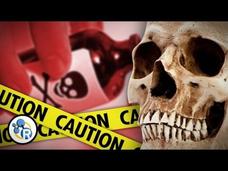PBS
The Risky Paleo Diets of Our Ancestors
We can track our history of eating just about anything back through the fossil record and see the impact it’s had on our evolution. Throughout time, part of the secret to our success as a species has been our early - and sometimes fatal...
TED-Ed
TED-Ed: Why don't poisonous animals poison themselves? - Rebecca D. Tarvin
Thousands of animal species use toxic chemicals to defend themselves from predators. Snakes have blood clotting compounds in their fangs, the bombardier beetle has corrosive liquid in its abdomen and jellyfish have venomous, harpoon-like...
SciShow
Antimony: The Life-Saving Toxin
Antimony is toxic to inhale, swallow and touch, but it might also save your life.
TED Talks
TED: 3 things men can do to promote gender equity | Jimmie Briggs
It is time for a gender reckoning, beginning with men authentically confronting our internal selves and each other, says essayist and intersectional justice advocate Jimmie Briggs. In this call to action for gender equity, he unpacks how...
Crash Course
The Excretory System: From Your Heart to the Toilet - CrashCourse Biology
Hank takes us on the fascinating journey through our excretory system to learn how our kidneys make pee.
Curated Video
I WONDER - What Is A Poison Dart Frog?
This video is answering the question of what is a poison dart frog.
Curated Video
GCSE Biology - Drug Development and Testing - Clinical Trials #45
Most drugs originate from nature e.g. from the back of a tree, but they have to refined and tested in clinical trials. Learn how this process works and the many stages we go through to ensure the final drug is effective.
Curated Video
Lithium vs. Antipsychotics: The Rise, Fall, and Rise Again of Lithium
Explore the journey of lithium, a game-changer in the late 1940s, as it transformed the treatment landscape for bipolar disorder. Join Dr. Tracey Marks, a dedicated psychiatrist, in this deep dive into the historical prominence of...
Curated Video
The Discovery and Uses of Fluorine: A Highly Reactive Element
This video provides an overview of the element fluorine, its properties, and its uses. Despite its reactivity, fluorine is used in dental care and pharmaceuticals due to its beneficial effects on teeth and its stable carbon-fluorine...
Learning Mole
Insect Ecology
This video will take students through how insects fit into their environments. It explores their habitats and the way they live.
Curated Video
The Elements: Uses and Importance in Everyday Life
Let's take a look back at the elements sodium, oxygen, argon, arsenic, and zinc.
Curated Video
The Versatile Uses of Lithium
This video provides an overview of lithium, its properties, and its various uses, including its use in lithium-ion batteries and in medications.
AFP News Agency
CLEAN : Norways fishing industry fights back after salmon scare
CLEAN : Norways fishing industry fights back after salmon scare
American Chemical Society
How Much Water Can Kill You?
Can water really poison you? An episode of the ACS Reaction series verifies that water can be toxic in large amounts. In fact, this is the main idea of the lesson: all elements are toxic at the right dose.
American Chemical Society
The Science of Caffeine: The World's Most Popular Drug
Discover the science behind the world's most popular drug. Scholars explore the neural effects of caffeine in an episode of the larger ACS Reactions playlist. The presenter explains how caffeine impacts different neurotransmitters in the...
American Chemical Society
How Does Tylenol Work? The Truth Is—We Don't Know
Surprise—even pharmacists don't know how Tylenol works! An installment of the ACS Reaction series considers three theories that explain the function of acetaminophen, the ingredient in the popular pain reliever Tylenol....
American Chemical Society
Why Is Chocolate Deadly for Dogs?
Is it true that chocolate can make dogs sick? If so, how much chocolate and how sick? Answer these and other related questions using a brief video from the American Chemical Society's Reactions playlist. The resource explores the...
Veritasium
Why Do Venomous Animals Live In Warm Climates?
Why do warm, tropical environments seem to be the perfect place to find so many of the world's most venomous animals? Explore several theories in an interesting video. The narrator differentiates between venomous and poisonous, describes...
SciShow
10 Plants That Could Kill You
Why shouldn't you eat that? The video gives an overview of several plants that are deadly to humans. The presenter explains the history and chemistry of each of the plants.
SciShow
How To Make Antivenom
You are nine times more likely to die from a lightning strike than a snakebite, thanks to anti-venom. But where does anti-venom come from? Viewers follow the process of making anti-venom, beginning with the discovery of how to make it...
SciShow
Top 5 Deadliest Substances on Earth
A crystal, the size of a grain of sand, of botulinum can kill 9,600 people. Viewers learn more about the five deadliest natural substances based on their ability to kill quickly with a video that also explains how these substances are...








